Spanning over 71,350 hectares of tropical forests, grasslands, and wetlands, Cat Tien National Park is home to a remarkable diversity of reptiles and amphibians, including many endemic species. Their presence is crucial to the ecosystem’s balance, highlighting the importance of conservation efforts in safeguarding Vietnam’s natural heritage.
Overview of Cat Tien National Park Reptiles and Amphibian Endemics
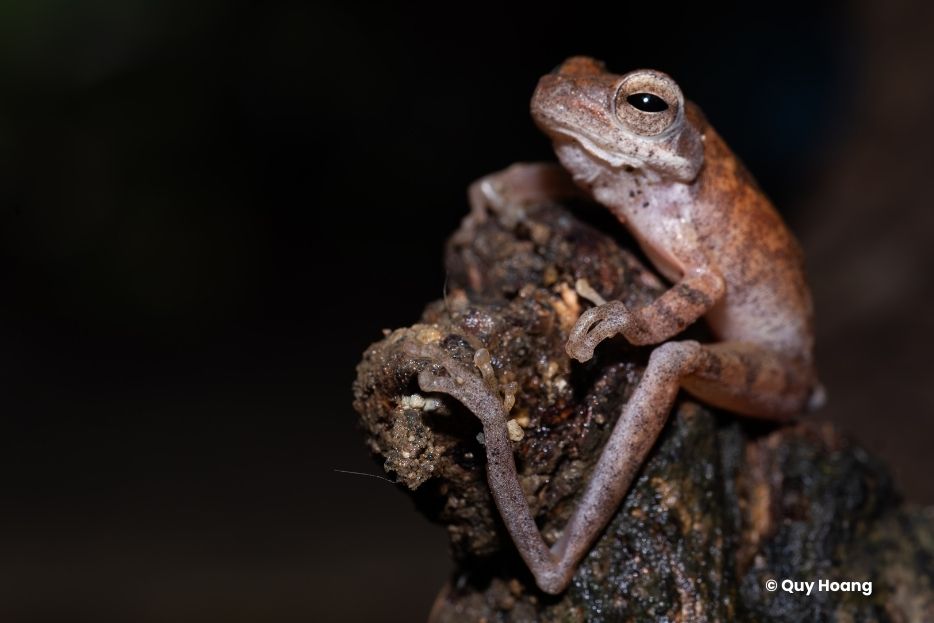
Cat Tien National Park is one of the most biodiversity hotspot in Vietnam, ranging from rich variety of birds, reptiles and amphibians to evergreen forests and wetlands. The park’s wetlands provide important habitats for amphibians, while its forested areas offer shelter for lizards and snakes.
The tropical monsoon climate plays a key role in their activity. During the wet season, amphibians thrive in the damp environment, and reptiles are more active in the dry season, soaking up the sun. If you’re interested in reptiles and amphibians, Cat Tien’s trails, wetlands, and rivers are great places to explore, making it a popular spot for wildlife lovers and researchers alike.
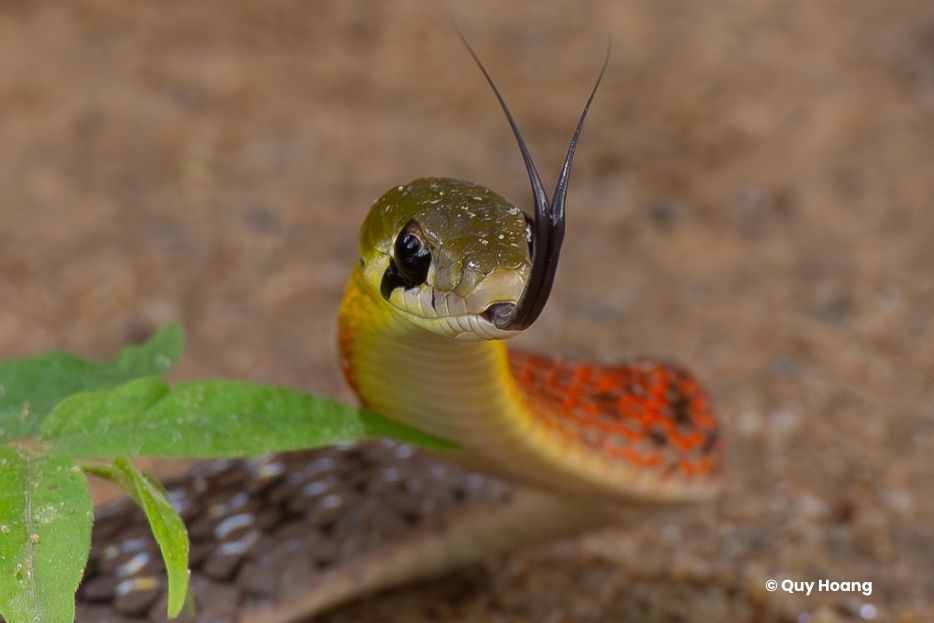
Endemic Species
Cat Tien National Park is home to numerous endemic species of reptiles and amphibians, which are unique to the region. The park’s isolation and specific environmental conditions have allowed these creatures to evolve separately, making them distinct from their relatives elsewhere in the world.
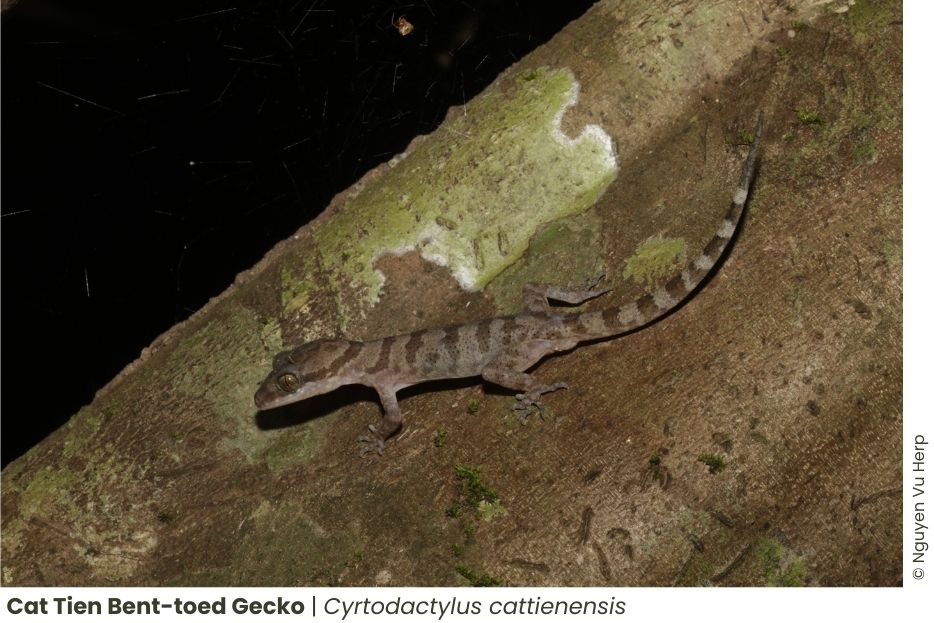
Endemic Reptiles:
- Cattien Bent-toed Gecko
- Ba Den Bent-toed Gecko
- Nguyenvansang’s Snake
- Sand Kukri Snake
- Huynh’s Bent-toed Gecko
- Ma Da Grass Lizard
Endemic Amphibians:
- Lam Dong Bamboo Sticky Frog
- Big-eared Odorous Frog
- Bamboo Moss Frog
- Tiny Narrow-Mouth Frog
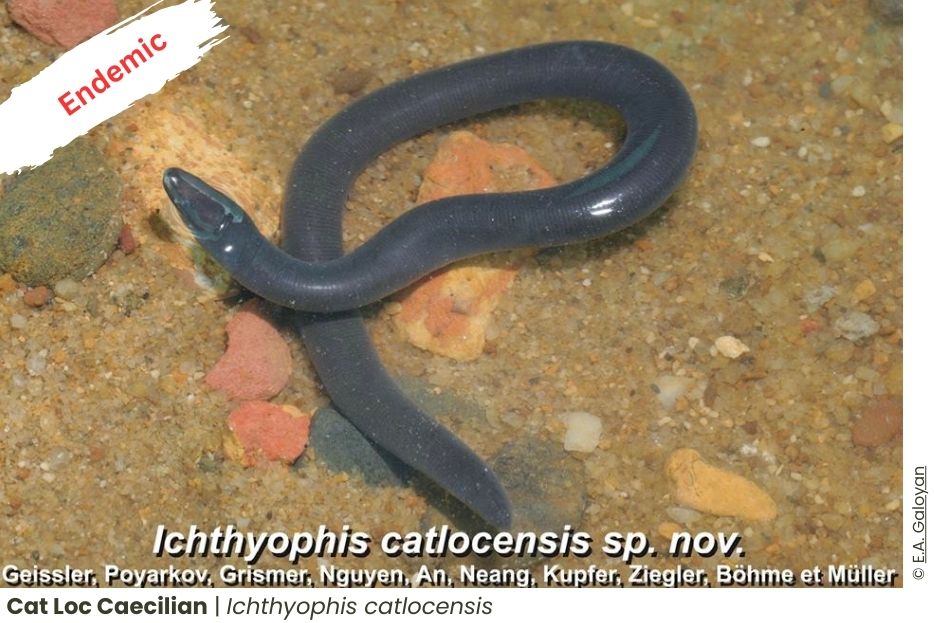
Each of these species plays a vital role in the ecosystem. The Cattien Bent-toed Gecko, for example, thrives in the park’s dense forests, while others like the Lam Dong Bamboo Sticky Frog depend on wetlands and rivers. These endemic species often face the highest risk of extinction due to habitat loss and human encroachment, making conservation efforts in Cat Tien National Park especially important.
Highlight Species
In addition to its endemic species, Cat Tien National Park is home to a wide range of notable reptile and amphibian. These fascinating creatures attract both wildlife enthusiasts and researchers, showcasing the park’s rich biodiversity.
Highlight Reptiles:
- King Cobra
- Reticulated Python
- Green Cat Snake
- Ruby-eyed Green Pit Viper
- Siamese Crocodile
Highlight Amphibians:
- Annam Flying Frog
- Helena’s Flying Frog
- Burmese Squat Frog
- Green Cascade Frog
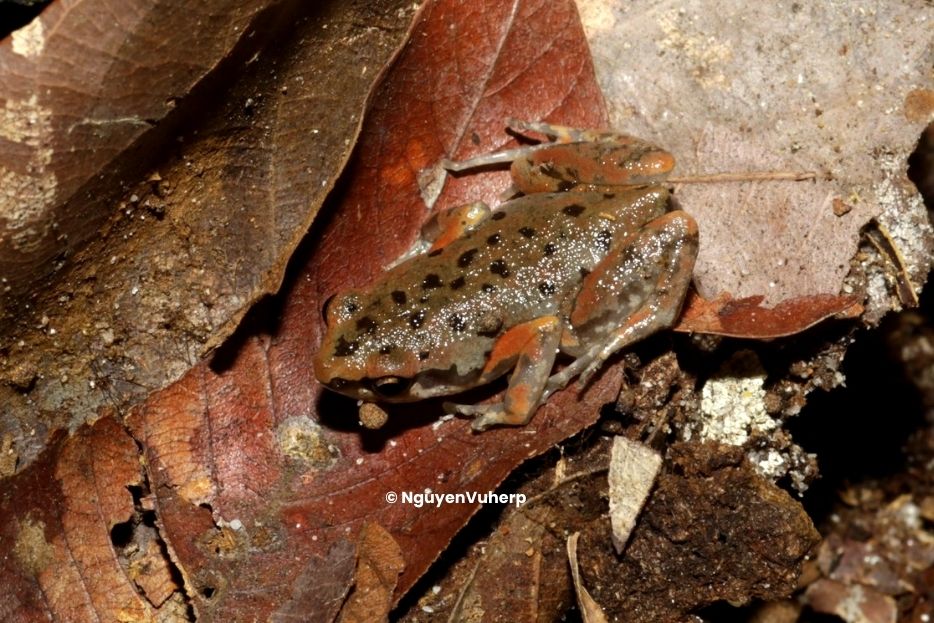
These highlights are not only fascinating due to their appearance and behavior, but they are also critical for the ecological balance of the park. The King Cobra plays a crucial role as a predator, controlling the populations of smaller snakes and rodents, while the Siamese Crocodile, once nearly extinct, has become a symbol of successful conservation efforts in the region.
Habitat and Conservation
As mentioned before, Cat Tien National Park’s biodiversity thrives in its varied habitats, including tropical rainforests, wetlands, rivers, and grasslands, all crucial for the park’s reptiles and amphibians. Wetlands and rivers provide essential moisture for amphibians, with frogs, toads, and salamanders becoming especially active during the wet season, often spotted on night herping tours. The park’s tropical forests provide shade, cover, and prey for reptiles like lizards, geckos, and snakes, such as the Annam Flying Frog and Cattien Bent-toed Gecko.
Conservation efforts in Cat Tien focus on preserving these habitats amid threats from deforestation, illegal logging, and wildlife trafficking. Habitat restoration, anti-poaching patrols, and community education are central to these initiatives. Eco-tourism, particularly herpetology tours, plays a key role by funding conservation projects and raising awareness about the importance of protecting these species, while also helping deter illegal activities.
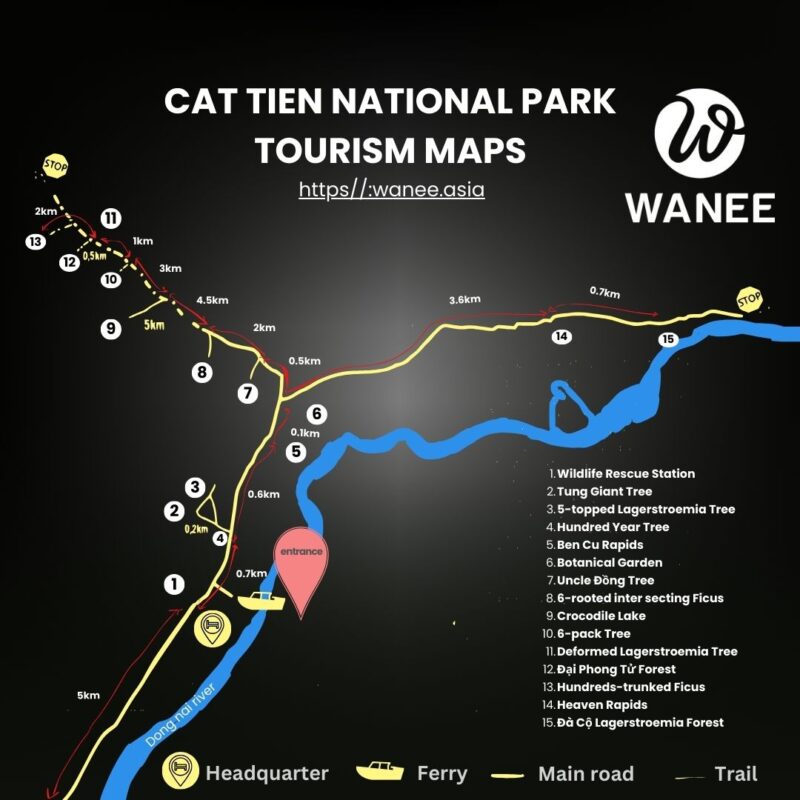
Best Time and Locations for Herpetology Tours
Cat Tien National Park offers a variety of herpetology tours, each providing visitors with the opportunity to observe reptiles and amphibians in their natural habitats. The best time for these tours depends on the species being targeted and the season.
Wet Season (May to October):
The wet season is the best time to observe amphibians, as they are most active during this time. The park’s rivers, wetlands, and swamps become prime locations for spotting frogs, toads, and salamanders. Night tours are particularly rewarding during this season, as many amphibians are nocturnal and can be observed during their breeding activities.
Dry Season (November to April):
The dry season is the ideal time to spot reptiles like snakes and lizards, as they are more active during the day when they bask in the sun. The park’s grasslands, riverbanks, and forest trails are excellent locations for observing reptiles during this time. Some species, like the King Cobra and Reticulated Python, are more easily seen during the dry season when they come out of hiding to search for prey.
Top Herping Locations in Cat Tien National Park:
- Crocodile Lake: This area is excellent for observing amphibians and aquatic reptiles, including the endangered Siamese Crocodile. The wetlands surrounding the lake are ideal for spotting frogs and toads, while the nearby grasslands are home to various snake species.
- Heaven Rapid Trail: A popular spot for sighting geckos and pit vipers. The dense forest cover provides the perfect environment for arboreal species, and night tours along this trail often yield sightings of frogs and geckos.
- Tung Tree Trail: Known for its rich biodiversity, this trail offers the chance to see both reptiles and amphibians. The trail winds through both wet and dry habitats, making it ideal for observing species like the Green Cascade Frog and the Ruby-eyed Green Pit Viper.
- Grassland Trail: This area is perfect for spotting larger reptiles like monitor lizards and pythons. The open grasslands provide plenty of opportunities to observe reptiles basking in the sun during the dry season.
- Uncle Dong Trail: A versatile trail that offers sightings of both reptiles and amphibians. It passes through different types of habitats, from dense forests to wetlands, providing ample opportunities for herping enthusiasts.
Join Our Conservation Journeys and Wildlife Tours to Cat Tien Herpetofauna!
Cat Tien National Park is a vital conservation area for reptiles and amphibians in Vietnam. Its diverse habitats support an incredible range of species, from endemic frogs and geckos to highlight species like the King Cobra and Siamese Crocodile. The park’s unique biodiversity makes it a haven for herpetology enthusiasts, offering unparalleled opportunities to observe and study these fascinating creatures in their natural environment. Through conservation efforts, eco-tourism, and research, Cat Tien National Park continues to play a crucial role in preserving Vietnam’s rich herpetofauna for future generations.
Across Vietnam, conservation efforts are expanding—from reforestation projects to wildlife rescue and habitat protection. At WANEE, we believe that the more we appreciate nature, the more we’ll want to protect it. That’s why our tours are designed to inspire a deeper love for wildlife and a stronger commitment to conservation. While trying harder every day to protect the balance of nature, our wildlife tours give tourists the chance to explore Vietnam’s natural beauty, understand how different habitats connect, and take action to protect them.
Scheduled Wildlife & Herping Tours
Tailored Cat Tien Herping Tours
Click here to see more tailored tour options
Visit our sites:
– Facebook: WANEE Vietnam (Wild and Nature Exploring)
– Instagram: WANEE Vietnam and WANEE Kids hub
Are you looking for Wildlife Tours in Vietnam?
WANEE VIETNAM is your go-to destination for "Wildlife Tours in Vietnam", specializing in Birding, Primate Watching, Herping, Photography Tours and Educational Tours led by our expert guides.Hot-spot for Birding in Vietnam
all birding in hot-spot informative info [updated Jan 2023]
Nr. Nature reserve; Np. National Park; mt. Mountain
Crocodile Trail – The Best Birding Trail in Cat Tien National Park
If you’re a birder or nature photographer planning a trip to Vietnam, few places offer [...]
Cong Troi Trail – Top 1 Dalat Plateau Birding Trail Experience
If you’re a birder or nature photographer planning a trip to Vietnam’s Central Highlands, the [...]
How to Identify the Greater Sand Plover, Tibetan Sand Plover and Siberian Sand Plover
Identification Differences within the Sand Plover Complex: The sand plover group, which was traditionally divided [...]
Highlights of Cat Tien National Park Reptiles and Amphibian Endemics
Spanning over 71,350 hectares of tropical forests, grasslands, and wetlands, Cat Tien National Park is [...]
Highlights of Cat Tien National Park Mammals in a World Biosphere Reserve
In addition to reptiles and birds, Cat Tien National Park is also rich in mammals, [...]
Kontum Plateau Endemic and Highlight bird
Kontum Plateau Endemic And Highlight Bird species like Chestnut-eared Laughingthrush and top birding routes while [...]